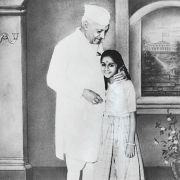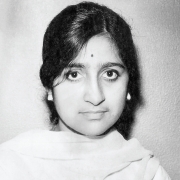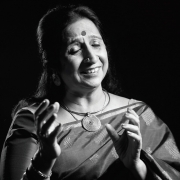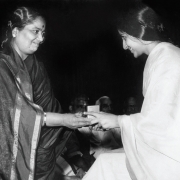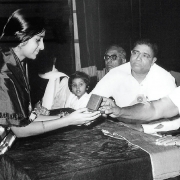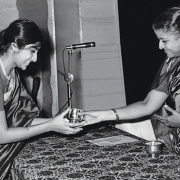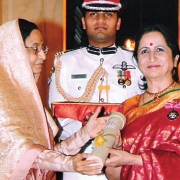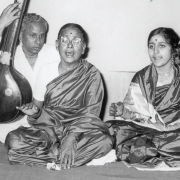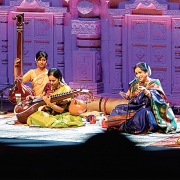
People
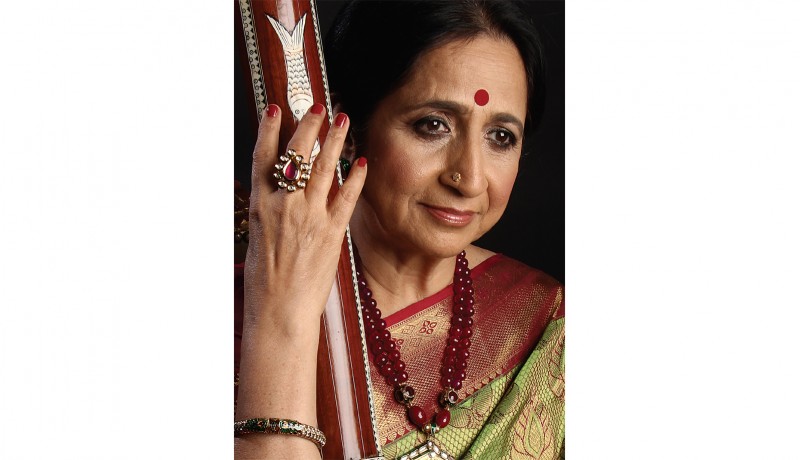
She brought in a whiff of fresh air to concert presentation while maintaining the purity of classical music. Rooted in tradition, veteran vocalist Aruna Sairam’s music has extended the realms of Carnatic repertoire. Chitra Ramaswamy speaks to one of the rare artists who has constantly reinvented herself and exemplifies the saying, ‘It is never too late to reach the top’
I am 15 minutes early for the 10 am appointment with Aruna Sairam, a Bombay-born, Chennai-based globetrotting musician. Shri Sairam, her spouse, greets me with a warm smile and welcomes me at the reception area of their three-storey villa in Alwarpet, an elite residential area in Chennai. Ms Sairam, he informs me, will return any moment from her ritual morning visit to the nearby temple. He engages me in pleasant conversation and extends his hospitality by offering a hot cuppa, which I politely decline. He follows my gaze as it comes to rest on a divinely crafted portrait of Krishna that adorns the room. “Yes, that’s Aruna’s favourite deity, something she has imbibed from her mother,” he shares. “Aruna had this specially made when we visited the Shrinathji temple at Nathdwara.”
In a few minutes, Aruna Sairam walks in, elegantly attired in an orange-pink, silk-cotton sari. If you didn’t know her, you could easily mistake her for a friendly neighbourhood maami. She is warm and friendly; a cherubic smile suffuses her face when I congratulate her on her most recent ‘Sangeetha Kalanidhi’ award, Madras Music Academy’s most prestigious accolade. “It’s all owing to the grace of the divine and the blessings of elders,” she says, as she leads me to the living room. The aesthetic decor of the space speaks volumes about the artist and art lover.
With a string of prestigious national and international awards and honours to her credit, including the Padma Shri (2009) and the US Congress Proclamation of Excellence (2008), Sairam is a musical ambassador, playing a major role in spreading the reach of Carnatic vocal music to the world. In 2011, in the 116-year history of the BBC Proms, she was the first Carnatic vocalist to perform at London’s Royal Albert Hall.
Indeed, Sairam is a musician who wears multiple hats. An astute thinker with a keen intellect, she is an articulate speaker who floors you with her fluency and felicity of expression. She is a mentor, musical guru, and teacher to several students, both within and outside the country. She travels widely across continents, addressing music forums, conducting workshops, lec-dems, and delivering lectures to students of music in Harvard and several European universities. Sairam is also a trained Bharatanatyam dancer who gave up the art form at the age of 14 to pursue music. Today, she interacts with dancers of various genres, composing and providing music for their performances.
What’s more, Sairam enjoys the privilege of having performed multiple times at Rashtrapati Bhavan before former presidents, prime ministers and other dignitaries. She has rendered concerts to packed halls at several prestigious venues, including New York’s Carnegie Hall, Théâtre de la Ville in Paris, and Morocco’s Fes Festival of World Sacred Music. She has collaborated with acclaimed international artistes and has released over 50 records that span classical repertoires and thematic presentations.
All this success sits lightly on the shoulders of the trendsetting vocalist who is endowed with a strong and vibrant voice, and is much appreciated for her rendition of abhang [devotional poetry]. Initiated into music at the tender age of three by her musician mother Rajalakshmi Sethuraman, Sairam entered the performing space as a youngster. She was privileged to begin formal training under the legendary T Brinda, the ‘musicians’ musician’, at the age of 10. She later widened her musical horizon, training under several maestros in the field.
However, for all her talents, Sairam’s rise to the top has been ridden with trials and struggles—she is one of those rare artists who had to constantly reinvent herself and beat the odds before finally making her mark on the firmament of Carnatic music when she was approaching middle age. Sheer grit, determination, a disposition to introspect, and humility to acknowledge mistakes and seek solutions, no matter from which quarter, are the qualities that have enabled her to prevail—and reach the enviable position she is in today.
EXCERPTS FROM AN INTERVIEW
How close is the Sangeetha Kalanidhi award to your heart, especially since you received the coveted Padma Shri several years ago, in 2009, besides a host of other honours?
I cherish every award for different reasons. The Padma Shri is a very special award because it comes from the country. To be an Indian citizen and receive this civil award is a completely beautiful experience and a matter of pride. The Sangeetha Kalanidhi Award, on the other hand, is awarded by the Carnatic fraternity and is on a different spectrum altogether. It is a recognition by the academicians of the field, thinkers, experts, pundits, writers, critics, connoisseurs and fans who come in large numbers to attend your concerts. It becomes an important validation within your community of scholars.
Carnatic and Western music critics have compared you to legends M S Subbulakshmi and jazz saxophonist John Coltrane. How does this feel?
There is an initial fizz of complete ecstasy because you never dreamt that you would be spoken of in the same breath as these great people. But once I go beyond that first moment and think what makes these legends great, they wore success lightly on their shoulders. MS amma, for instance, who was decorated with the Bharat Ratna, was a student of music till the end of her life. She had a sense of childlike wonderment before every concert. She was humble and knew her responsibility every time she went on stage and never took it for granted. So it becomes my responsibility too, to see every day as a new day. I need to ensure I am growing every day. As long as I keep that intact, I can keep having these momentary, absolutely wonderful moments of joy that come my way.
As a teen, while singing in front of MS, you burst into tears because you were unable to negotiate the higher reaches of a piece. What impact did this have on you?
This happened when MS amma came to Bombay. I was 15 then, and was having adolescence-related voice problems. As was the usual practice, my parents took me to visit her and offer my namaskaram. When she asked me to sing, I sang a piece that had won me a prize in a competition two days earlier. I began well but could not negotiate the higher octave. I choked and couldn’t continue. I broke into tears before her. I thought the whole world had fallen apart; that I had lost a wonderful chance to impress this great lady and my future was gone. She came and sat next to me, put her hand on me in a mild hug and asked me if I was worried because of my big voice. To reassure me, she narrated her own experience of her younger days when she would be criticised for her powerful tonality. And then she said, “But see today how people from all over the world flock to hear me. Wait and see. One day, the whole world will hear your music… so shed your fears and anxiety.” These were magical words for me! If a legend of her stature could say this of me, I felt I had something in me that merited that statement.
Meeting voice maestro Eugene Rabine was a turning point in your life. What prompted you to undergo training under him?
The desire to improve myself has always been a part of me. The incident that happened before MS amma remained deeply etched in my memory. Even though I was singing in my early 20s, I felt the output needed more polish. I was on a quest to discover voice masters who could help me. During one of my tours to Europe as a guest lecturer, I met Eugene Rabine and instinctively knew he was the right person. My training period with him lasted only a few days. But in those few days, he changed my perception of the voice. I came to realise that singing is not about the voice as an instrument sitting at the throat area—it is the entire body that is singing! Practises and exercises followed. Within two years, my voice started changing. My feelings when I sang, the way I was before a concert, and during a concert, changed. Mentally, physically, psychologically—just everything changed.
Had you always aspired to be a musician?
I was very good at academics and pursued my under graduation in chemistry and botany from SIES College in Bombay and subsequently did a B.Ed from St Xavier’s College. I stood second in the university in both these courses. At one time, I cherished the desire to pursue a doctorate in organic chemistry. I had dreams, but nothing really concrete.
When did music take precedence over these dreams?
Following the demise of my mother, I think. I was 22, married, and with a daughter who was a year-and-a-half. I did not have an ordinary musical upbringing. My mother, who was my first teacher, was an accomplished musician. I then had the privilege of learning under Brinda amma, who was a very exclusive teacher. From the age of three till my early 20s, I was learning classical music of a very high quality. I wondered at the sacrifices my parents must have made, not only to get Brinda amma to teach me, but all those constellation of musicians who would visit our humble 650-sq-ft home in Bombay. They would visit us for the sheer love of the art… my parents used to keep an open house because they loved music. And they did all this without any agenda; they didn’t think I was going to become a musician. So when I realised the richness of all this formal and non-formal learning and the exposure I got in legacy, it set me thinking.
Once you realised this, how did your musical journey progress? How easy was it for you to juggle between being a musician and homemaker?
There is no easy path for anybody anywhere. Mine has been a very chequered professional life. Following the birth of my two daughters, I put my career on hold because I didn’t want to uproot my family. But to be honest, I had not, until then, found my focus. I was not sure what I wanted to do. My mother’s loss set me on an inward journey. I wondered what I was doing with the gift of music she had given me. With each passing day, the question loomed larger. Ten years had elapsed before I realised that music was my true calling. But it is not that I had not been singing in those years. My dad, who didn’t know music but was passionate about it, would come to my house twice a week and be my sole audience for three hours. I would sing for him as in a concert. I was also making a few concert appearances at various cities where I was invited. I was known as a talented singer, but I was not an obsessively passionate singer; that came a little later. But I am happy my children were raised in the process and I’m so proud of the way they are today.
So, it had been a balancing act all the while?
Totally. As my daughters started growing older, the moment they’d leave for school, I would start singing, practising, exploring, building my gravitas around several things. This was the period when I learnt various aspects of music with several gurus. I also began accepting invitations to tour Europe. The huge cultural shock I experienced there made me rediscover my origins, made me realise and cherish what I had in my life. It was a whole process of alchemy that drove me to get more focus.
And you finally arrived….
It was not that easy. Through good and bad incidents and the pains of life, when I did find my focus and set out to make my mark musically, I had no clue about concert craft, which is another cup of tea altogether. There were no takers for my concerts. I realised that success in a field is not just about knowledge, talent and proficiency. While they are all integral parts, how you present them to the people is equally important. By the time I realised this, I was almost middle-aged and I still didn’t know how to go about it.
But all the while, there was one thing of which I was certain: I knew that with my focus in place, I would be there. I never doubted this. It was this belief that carried me through despite the failures, delays and downsides.
But you have absolutely made it to the top! How did the change happen?
Unknowingly, I adopted a very modern concept: feedback! I formed a trio with two of my friends-cum-well-wishers to give me feedback on what I did. These two people are neither my gurus nor are they musicians. They are just people I trust; I trust their instincts. Every concert, every piece, every strategy and everything I did, I would put through this crucible. This involved hours of working, practising, rehearsing. We would scrutinise it from various angles, from the perspective of audience, connoisseurs, critics, before I would render a concert on stage. This exercise really helped me. It was about finding that bridge between what I was doing and what people are receiving. This was an essential link in my life that unfolded before me. Life is a never-ending process of learning, at different levels and aspects. And in this journey, anybody can be your mentor—you don’t know when and where that mentor will come up; but you have to have the wisdom to recognise them when you see them. What really helped me through these years of pain and struggle was the support I received from my family and in-laws. My husband never questioned my decisions. He trusted and supported me completely.
Creativity in any form of art blossoms when there is a lot of pain. Do you agree?
Absolutely. Creativity comes from life. I went through a lot of ups and downs in life, the pains and pleasures of a householder, a lot of confusion and uncertainty. I didn’t even know what I was going to do in life. And once I embarked on performance with focus, I was not a success. I had very few people attending my concerts in the early years. I had to start rethinking, reinventing myself. When you raise two children, there’s pain and bits of pleasure thrown in now and then. All that is expressed in your music.
Do you allow your moods to dictate your concerts? After all, moods do influence creativity.
I don’t have the luxury where my moods can dictate my performances. No matter what, once I’m on stage, music takes over and I am determined to give my best. Fortunately, because of my spiritual background and love for Lord Krishna, I view my performance as an offering to Him. So, everything else is eclipsed and it’s only music all the way.
How did the album, Aruna: Thousand Names of the Divine Mother, come to be recorded in the crypt of a church in Germany?
This happened sometime between 1993 and 1995, when I was travelling by road with German musicians Christian Bollmann and Michael Reimann. We were doing a series of concerts at a few places in Germany. Suddenly, Christian asked me what prayer I say every day. In response, I started chanting the Lalitha Sahasranamam [1,000 names of the divine mother], with which I begin my day. He was spellbound. Whatever followed was like a dream. Christian drove us to this church in some small village, asked me to get into the crypt and begin reciting the Lalitha Sahasranamam. Michael accompanied me on the church organ while Christian himself played the didgeridoo, an Australian aboriginal instrument. The 70-minute album became a big hit.
Please tell us about your rendition in the French musical Le Babe Bleu.
This happened in 1997. Following my performance at the Theatre De La Vie and other venues, French theatre director Dominique Pompougnac approached me. He wanted to do the story of the birth of Krishna in French. The whole story was enacted as theatre with puppetry, narration, music and dance. I was the vocalist accompanied by flute and mridangam. The narration was in French. It did well with over 40 performances across France.
You have recorded over 50 albums, collaborating with musicians across the world. Which is your personal favourite?
I cherish each one of the albums and collaborations. That said, Dominique Vellard, a master of Gregorian and medieval songs, Noureddine Tahiri, the Moroccan Sufi vocalist, and I collaborated on Trialogue, a concert album in 2012. This was a beautiful blend of my South Indian, Dominique’s medieval liturgical and Tahiri’s Moroccan devotional music. For me, this concert was a very spiritual experience because it was the coming together of Hinduism, Christianity and Islam—East, West and Middle East.
In 2012, you established the Nadhayogam Trust. What was the idea behind this?
The idea is to do a lot of sharing and caring. Once you attain a certain level, you want to give back. This is human nature. I’m not doing anything unusual. We help poor students buy instruments to pursue their music, give stipends to young students, create space for old and young musicians to come together, and create an osmotic symbiosis between senior and junior musicians.
You’ve been engaged in philanthropic work, particularly relating to cancer. Is there any particular reason for this?
I know what it is to have a near and dear one suffering from cancer. That is why I would like to give as much as possible towards the cause. Through my concerts, I have been able to raise substantial funds to chip in my bit for cancer hospices, setups where they offer treatment, succour and comfortable facilities to these patients.
Are your daughters also into music?
They love music but have taken up other professions. One is in the US and the other in the UK.
How has music affected you as a person and what does it mean to you?
I feel blessed to be in this field. It has taught me to live the moment without any expectations. You have to do your work with full faith; after having done so, you have to accept the fact that you have no part in its outcome.
Photos courtesy: Aruna Sairam Featured in Harmony — Celebrate Age Magazine December 2018
you may also like to read
-
For the love of Sanskrit
During her 60s, if you had told Sushila A that she would be securing a doctorate in Sanskrit in the….
-
Style sensation
Meet Instagram star Moon Lin Cocking a snook at ageism, this nonagenarian Taiwanese woman is slaying street fashion like….
-
Beauty and her beast
Meet Instagram star Linda Rodin Most beauty and style influencers on Instagram hope to launch their beauty line someday…..
-
Cooking up a storm!
Meet Instagram star Shanthi Ramachandran In today’s web-fuelled world, you can now get recipes for your favourite dishes at….



